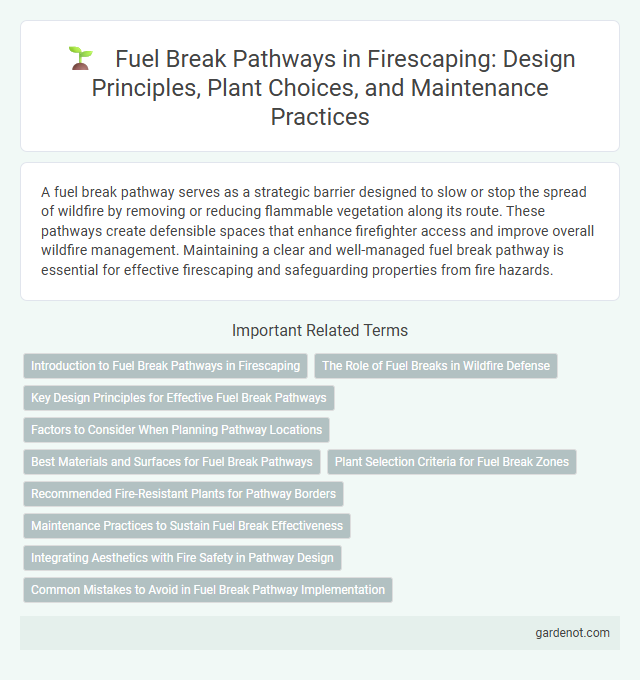A fuel break pathway serves as a strategic barrier designed to slow or stop the spread of wildfire by removing or reducing flammable vegetation along its route. These pathways create defensible spaces that enhance firefighter access and improve overall wildfire management. Maintaining a clear and well-managed fuel break pathway is essential for effective firescaping and safeguarding properties from fire hazards.
Introduction to Fuel Break Pathways in Firescaping
Fuel break pathways in firescaping serve as strategically cleared or maintained strips of land designed to reduce wildfire intensity and slow its spread by removing or modifying vegetation. These pathways create defensible zones that protect properties and critical infrastructure while supporting fire management efforts. Implementing fuel break pathways involves selecting appropriate width, vegetation types, and maintenance schedules to optimize fire resilience and ecosystem health.
The Role of Fuel Breaks in Wildfire Defense
Fuel breaks act as strategic clearings that reduce combustible vegetation, slowing wildfire spread and providing crucial safety zones for firefighters. They function as barriers that interrupt the continuity of fuels, helping to control fire intensity and direction. Effective fuel break pathways enhance wildfire defense by facilitating access for suppression efforts and protecting vulnerable properties.
Key Design Principles for Effective Fuel Break Pathways
Effective fuel break pathways prioritize creating defensible spaces by removing flammable vegetation and incorporating low-combustion ground covers to interrupt wildfire spread. Properly designed fuel breaks maintain sufficient width based on local topography and prevailing wind conditions, ensuring easy access for firefighting equipment and personnel. Strategic placement along natural fire barriers, combined with regular maintenance, enhances their long-term effectiveness in reducing fire intensity and providing safe evacuation routes.
Factors to Consider When Planning Pathway Locations
When planning the location of fuel break pathways in firescaping, consider factors such as vegetation type, slope gradient, and prevailing wind direction to effectively reduce fire intensity and spread. Proximity to structures and accessibility for firefighting equipment are critical to enhance safety and operational efficiency. Soil erosion potential and ecological impact should also be evaluated to maintain long-term landscape health and fire resilience.
Best Materials and Surfaces for Fuel Break Pathways
Gravel, crushed stone, and decomposed granite are among the best materials for fuel break pathways due to their durability and fire-resistant properties. These surfaces limit vegetation growth and reduce combustible material buildup, creating effective barriers against wildfire spread. Incorporating non-flammable materials like concrete or asphalt can further enhance pathway fire resistance and accessibility for emergency vehicles.
Plant Selection Criteria for Fuel Break Zones
Plant selection criteria for fuel break zones emphasize low flammability, drought tolerance, and minimal litter production to reduce wildfire risk. Species chosen should have high moisture content, non-resinous foliage, and deep root systems that promote soil stability. Implementing plants with these characteristics aids in creating effective fuel breaks by interrupting fire spread and enhancing landscape resilience.
Recommended Fire-Resistant Plants for Pathway Borders
Recommended fire-resistant plants for fuel break pathway borders include lavender, rosemary, and California lilac, which have low resin content and high moisture levels. These species create effective natural barriers that slow wildfire spread while maintaining aesthetic appeal. Incorporating drought-tolerant, fire-adapted shrubs improves pathway safety and reduces combustible material accumulation.
Maintenance Practices to Sustain Fuel Break Effectiveness
Regular maintenance of fuel break pathways involves clearing accumulated vegetation, debris, and dead organic matter to reduce fire fuel load and maintain fire retardant properties. Practices such as periodic mowing, pruning, and removal of invasive species help preserve the effectiveness of fuel breaks by preventing regrowth that could serve as a fire hazard. Consistent inspection and prompt repair of erosion or pathway damage ensure uninterrupted function of fuel breaks in wildfire prevention and control.
Integrating Aesthetics with Fire Safety in Pathway Design
Fuel break pathways enhance fire safety by strategically reducing combustible vegetation while maintaining visual appeal through thoughtful landscaping choices. Incorporating drought-tolerant plants, non-flammable materials, and curved pathway layouts promotes natural aesthetics without compromising fire mitigation effectiveness. This balance supports both wildfire resilience and an attractive outdoor environment, optimizing protection and curb appeal.
Common Mistakes to Avoid in Fuel Break Pathway Implementation
Fuel break pathway implementation often suffers from common mistakes such as inadequate clearing width and inconsistent maintenance, which reduce its effectiveness in slowing wildfire spread. Failing to remove fine and ladder fuels can allow fire to jump the break, undermining the purpose of the fuel break. Proper design should prioritize continuous vegetation management and strategic placement to maximize the barrier's protective function in firescaping.
Fuel break pathway Infographic

 gardenot.com
gardenot.com